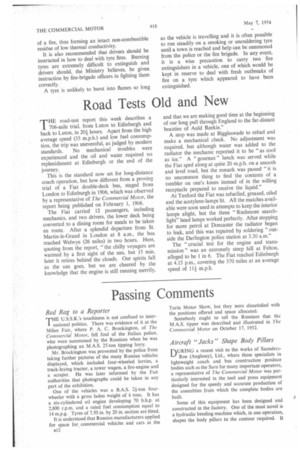Road Tests Old and New
Page 38

If you've noticed an error in this article please click here to report it so we can fix it.
THE road-test report this week describes a 706-mile trial, from Luton to Edinburgh and back to Luton, in 20f hours. Apart from the high average speed (35 m.p.h.) and low fuel consumption, the trip was uneventful, as judged by modern standards. No mechanical troubles were experienced and the oil and water required no replenishment at Edinburgh or the end of the journey.
This is the standard now set for long-distance coach operation, but how different from a proving trial of a Fiat double-deck bus, staged from London to Edinburgh in 1906, which was observed by a representative of The Commercial Motor, the report being published on February 1, 1906.
The Fiat carried 12 passengers, including mechanics, and two drivers, the lower deck being converted to a dining room for meals to be taken en route. After a splendid departure from St. Martin-le-Grand in London at 8 a.m., the bus reached Welwyn (26 miles) in two hours. Here, quoting from the report, 'the chilly voyagers are warmed by a first sight of the sun, but 15 min. later it retires behind the clouds. Our spirits fall as the sun goes, but we are cheered by the knowledge that the engine is still running merrily, and that we are making good time at the beginning of our long pull through England to the far-distant beauties of Auld Reekie."
A stop was made at Biggleswade to refuel and make a mechanical check. No adjustment was required. but although water was added to the radiator the mechanic reported it to be "as cool as ice." A " gourmet " lunch was served while the Fiat sped along at quite 20 m.p.h. on a smooth and level road, but the remark was passed "it is no uncommon thing to find the contents of a tumbler on one's knees instead of in the willing receptacle prepared to receive the liquid."
At Tuxford the Fiat was refuelled, greased, oiled and the acetylene-lamps lit. All the matches available were soon used in attempts to keep the interior lamps alight, but the three "Rushmore searchlight" head lamps worked perfectly. After stopping for more petrol at Doncaster the radiator began to leak, and this was repaired by soldering "outside the Darlington police station at 3.30 a.m."
The "crucial test for the engine and transmission" was an extremely steep hill at Felton, alleged to be 1 in 6. The Fiat reached Edinburgh at 4.15 p.m., covering the 370 miles at an average speed of 111 m.p.h.








































































































